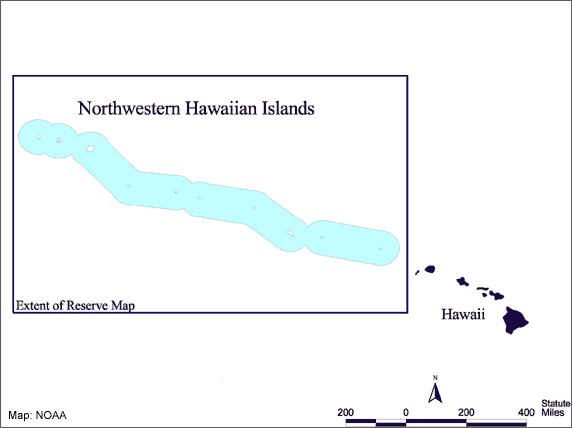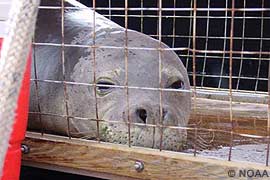

 |
||
 |
||
Vol. 6 (2): December 2003 |
Download this page
|
|
Update on efforts to protect the Northwestern Hawaiian Islands:
|
 |
|
NWHI Coral Reef Ecosystem Reserve (click here for more detailed map) |
We are not assured by the nature of this process for the following reasons:
To stay informed of upcoming public comment opportunities, sign up with the Action Alert Network at www.kahea.org or www.environmentaldefense.org/hawaii.
You will receive notification of upcoming hearings with important background information and have the opportunity to fax your comments directly to decision-makers.
For more information, please feel free to contact:
 |
 |
|
|
KAHEA: The Hawaiian-Environmental Alliance Tel. (808) 524-8220 |
Environmental Defense/Hawai‘i Tel. (808) 262-7128 |
Fried, S. 2003. Comments of Environmental Defense concerning the draft EIS for bottomfish and seamount groundfish fisheries in the Western Pacific Region, December 1, 2003: 1-5. [![]() 84KB].
84KB].
Smith, C. 2003. Northwestern Hawaiian Islands – Creating a Pu’uhonua for Future Generations, TMG 6 (1): June 2003.
For better or worse, monk seals have appeared in the Hawaiian press and media on numerous occasions over the last few months – often reflecting ambivalent human attitudes towards a species that is beginning to recolonize the main Hawaiian Islands and is often not too shy about it, either. Human-seal interactions, sometimes just too rough-and-tumble for bathers, prompted the US Department of Land and Natural Resources to issue a news release on 30 October 2003 [Do Not Feed or Interact with Hawaiian Monk Seals, ![]() 124KB], “reminding boaters, fishermen, swimmers and others, that it is against state and federal laws to feed or harass endangered Hawaiian monk seals. It is harmful to the animals and dangerous to people.”
124KB], “reminding boaters, fishermen, swimmers and others, that it is against state and federal laws to feed or harass endangered Hawaiian monk seals. It is harmful to the animals and dangerous to people.”
For one young monk seal offender, however, it was a case 3 strikes and you’re out: designated seal RM-32 was banished to the former US nuclear test site of Johnston Atoll for frolicking rather too roughly – and in some cases, amorously – with bathers.
A Hawaiian monk seal that developed a fondness for interacting with humans has been relocated to remote Johnston Atoll, the Coast Guard said Tuesday (West Hawaii Today, HI).
 |
|
|
RM-34 on his way into exile. |
A mischievous Hawaiian monk seal was banished to Johnston Atoll yesterday, after weeks of groping beachgoers on Maui and the Big Island. The endangered 300-pound male monk seal known as RM-34 was flown 800 miles away to the Northwestern Hawaiian Islands aboard a Coast Guard C-130 Hercules from Air Station Barbers Point (Honolulu Advertiser, HI).
A Hawaiian monk seal was airlifted by the Coast Guard on Monday afternoon to Johnston Atoll, where it is hoped he will frolic with other seals rather than humans (Honolulu Star-Bulletin, HI).
A Big Island–born Hawaiian monk seal has learned the truth of the saying “You snooze. You lose.” (West Hawaii Today, HI).
A playful but dangerous Hawaiian monk seal that eluded capture on Maui’s south coast this week finally ran out of luck yesterday. The seal known as RM-34 rests in a cage on Maui after a shot of Valium (Honolulu Advertiser, HI).
A playful Hawaiian monk seal that evaded capture for three days while he frolicked with swimmers was caught yesterday morning at La Perouse Bay on Maui and is headed for Johnston Atoll. (Honolulu Star-Bulletin, HI).
A Hawaiian monk seal born on a remote Ka’u beach in 2001 is about to undergo his third relocation in a month after repeated interactions with humans. Wildlife officials say the behavior by the seal known as RM34 – playing with swimmers who are occasionally nipped and groped – is unhealthy for the animal and potentially dangerous for swimmers (Hawaii Tribune-Herald, HI).
The mammals might look cute but they can bite, experts caution. A 300-pound Hawaiian monk seal that has been relocated twice in the past month because it nipped and groped swimmers eluded capture by wildlife officials yesterday on Maui (Honolulu Star-Bulletin, HI).
He’s back – and he’s up to his old tricks. A frisky monk seal that was twice moved from a popular swimming area on the Big Island because of his naughty – and potentially dangerous – behavior has found his way back to civilization, this time on Maui (Honolulu Advertiser, HI).
These data required NMFS to classify the fishery as Category I and to begin preparing take reduction plans for the false killer whale and other imperiled marine mammal species in Hawaiian waters. In refusing to designate the Hawai‘i longline fishery as a Catagory I fishery, NMFS has failed to fulfill its kuleana (responsibility) and ignored its mission, resulting in additional needless deaths of false killer whales in Hawaiian waters,” said William Aila of Hui Malama i Kohola (Earth Justice, CA).
Hawaii researchers see the monk seal in Kahoolawe waters. An endangered Hawaiian monk seal that was twice removed from Kealakekua Bay last month because he was “nipping and groping” swimmers may be settling in with his own kind off Kahoolawe (Honolulu Star-Bulletin, HI).
The University of Hawaii ship Ka‘imikai-o-Kanaloa returned from a Northwest Hawaiian Islands expedition on Wednesday… A UH vessel with subs finds new coral species and spots a monk seal in the deep ocean (Honolulu Star-Bulletin, HI).
 |
|
|
Endangered Hawaiian monk seals interacting with swimmers at Poipu Beach, Kauai, April 2003. |
Wildlife officials are warning people to avoid feeding or touching Hawaiian monk seals, after two of the endangered animals were getting too cozy with humans on Kauai and the Big Island. People have recently been feeding an adult male known as K07, or “Lucky,” in Kauai’s Nawiliwili Harbor. The animal swims up to docks and begs for fish, said Shawn Farry, a biologist who has researched monk seals in the Northwestern Hawaiian Islands for the National Oceanic and Atmospheric Administration’s Fisheries Service (Honolulu Star-Bulletin, HI).
State, Federal Agencies Remind Public: Do Not Feed or Interact with Hawaiian Monk Seals. The Department of Land and Natural Resources and the National Marine Fisheries Service (NOAA Fisheries, U. S. Department of Commerce) are reminding boaters, fishermen, swimmers and others, that it is against state and federal laws to feed or harass endangered Hawaiian monk seals. It is harmful to the animals and dangerous to people (Department of Land and Natural Resources).
The frisky monk seal of Kealakekua Bay on the Big Island was back at his old stomping grounds this weekend after he swam back from the waters off the southern tip of the island last week. The 2 1/2-year-old Hawaiian monk seal called RM34 was sent to his birthplace off South Point after his antics which included nipping and groping became a danger to himself and swimmers (Honolulu Advertiser, HI).
A frisky Hawaiian monk seal was moved from Kealakekua Bay on the Big Island after its playful antics became a danger to swimmers, federal marine fisheries officials said yesterday. Close interaction with people, as displayed in this photo taken Sunday, led to the transfer of a 2 1/2-year-old Hawaiian monk seal from Kealakekua Bay to waters closer to its birthplace (Honolulu Advertiser, HI).
A two-year-old Hawaiian monk seal has been returned to his birth area after he was reported to have come into contact with some swimmers in Kealakekua Bay, wildlife officials said Wednesday. The seal was captured and returned to his birth area in a remote location at the southern end of the Big Island to prevent further interaction with swimmers and possible harm, the National Oceanic and Atmospheric Administration’s National Marine Fisheries Service said (West Hawaii Today, HI).
Projects include protected species investigations such as the Hawaiian monk seal program, coastal research on the Northwest Hawaiian islands marine debris program and coral reef mapping and climate research. “The support provided by NOAA has enabled our students and researchers to participate in research investigations and activities that have implications not only for Hawaii’s marine and atmospheric environments but for the nation and the entire world as well,” said Tom Schroeder, director of the Joint Institute for Marine and Atmospheric Research (Pacific Business News, HI).
A series of meetings about a proposed National Oceanic & Atmospheric Administration study of endangered Hawaiian monk seals in the main Hawaiian Islands begins today on Molokai. Robert Braun, a marine mammal specialist, will lead the project to find out more about the monk seal’s health, foraging ecology and habitat use (Honolulu Star-Bulletin, HI).
Hawaii will receive about $13.7 million in federal funds for research and management of the islands’ fisheries and ocean resources, U.S. Sen. Daniel Inouye’s office announced. About $8.7 million is earmarked for initiatives including further study of the endangered monk seal, coral reef health research and management, and physical oceanography and climate change, Inouye said in a news release.
That gill net, like another found nearby two weeks later with three dead harbor seals inside, is just the visible tip of an undersea tangle. These ghost nets, mostly gigantic trawl nets arriving from thousands of miles away, are the most serious threat to the survival of the Hawaiian monk seal, America’s most endangered marine mammal (Christian Science Monitor).
Cover Story: Plundering the Pacific: the cats who run the fishhouse – by Paul Koberstein…
EndQuoteSeal fallout“The Defense Department’s decision to economize in the control of radioactive rubble left over from nuclear testing on Johnston Atoll is causing legitimate concerns about the long-term environmental risk… The Air Force conducted a dozen nuclear-test launchings in the 1950s and 1960s at the four-island atoll, less than 800 miles southwest of Honolulu. Two of the missiles exploded over the runway on Johnson Island, the largest of the islands. The government has spent four decades gathering the 60,000 cubic yards of radioactive contaminants that the aborted tests sprayed over Johnston Island. Manmade plutonium, one of the most hazardous elements in the rubble, is estimated to pose a danger for 6,000 to 24,000 years.”
|
Copyright © 2003 The Monachus Guardian. All Rights Reserved |